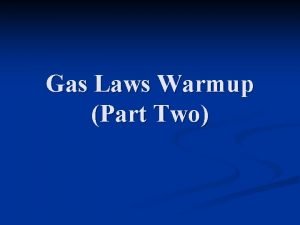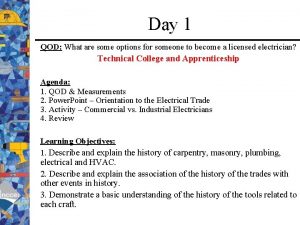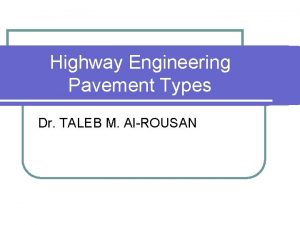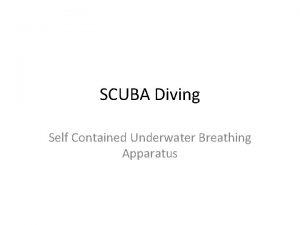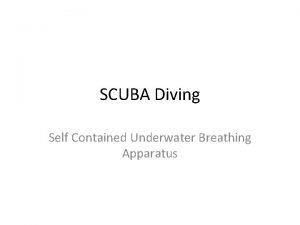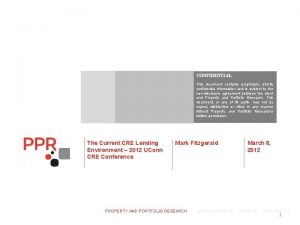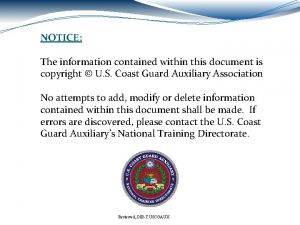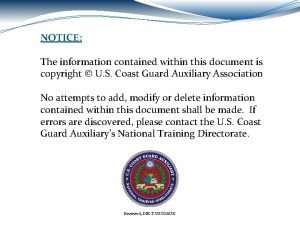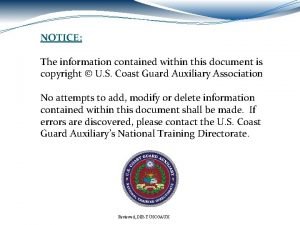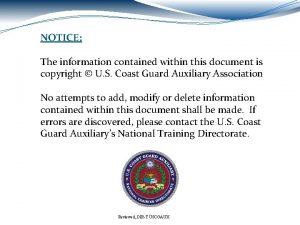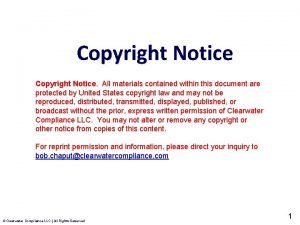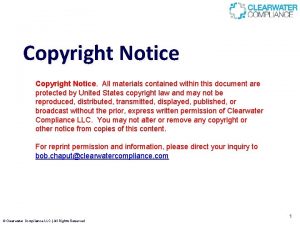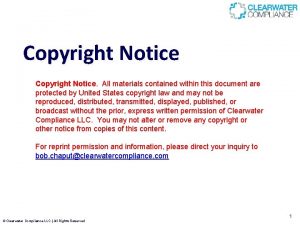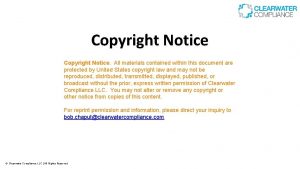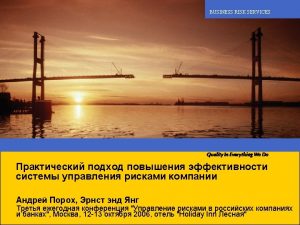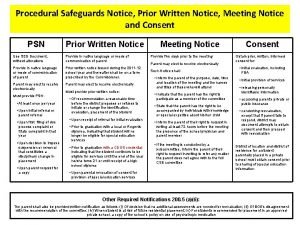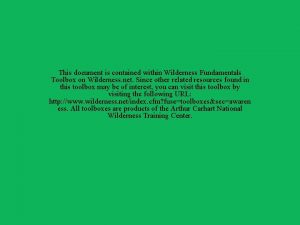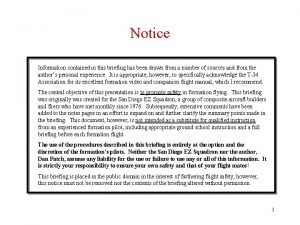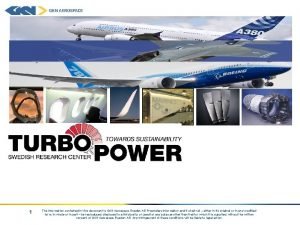NOTICE The information contained within this document is































- Slides: 31

NOTICE: The information contained within this document is copyright © U. S. Coast Guard Auxiliary Association No attempts to add, modify or delete information contained within this document shall be made. If errors are discovered, please contact the U. S. Coast Guard Auxiliary’s National Training Directorate. Reviewed, DIR-T USCGAUX

WEATHER Specialty Course AUXWEA Chapter 2 – Pressure and Winds Reviewed, DIR-T USCGAUX

Section 1 Surface Pressure and Winds Reviewed, DIR-T USCGAUX 3

Overview Surface Pressure: Definition of pressure, common units and common instruments. Station pressure and sea-level pressure. Pressure on common surface charts—isobars and station model. Pressure Gradient Force (PGF). Surface Winds: Definition of wind direction and comparison with currents. Wind circulation and the balance between Coriolis and the PGF. The effect of friction on winds. Changes in direction—veering and backing winds. Where is the Low? —the Buys-Ballot Law. Local effects—sea breeze and land breeze Reviewed, DIR-T USCGAUX 4

Surface Pressure is force per unit area. Pressure exerts equal force in all directions. Atmospheric pressure is due to the weight of the over-lying air. Pressure decreases with altitude (rate depends on temperature). Useful measurement is the pressure tendency (change in 3 hrs). The change of pressure with distance is called the Pressure Gradient, and it results in a horizontal force, the Pressure Gradient Force (PGF), that drives the winds. • Pressure is measured with a barometer and is reported in different units for different purposes (next slide). Reviewed, DIR-T USCGAUX 5

Barometers and Units of Pressure Examples of Barometers. Mercury and aneroid. All barometers are subject to error and must be calibrated. Station pressure is converted to sea-level pressure for reporting. Units of Pressure. lb/square inch 14. 7 psi. inches of Mercury 29. 92 in Hg. mm of Mercury 760 mm Hg. Millibars (mb)* 1013. 25 mb. Kilo-Pascals 101. 325 k. Pa. * Also called hecto-Pascals (h. Pa) Reviewed, DIR-T USCGAUX © 2008, US Power Squadrons. Reprinted with permission 6

Pressure Gradient Force (PGF) © 1997, USA Today. Reprinted with permission A change of pressure with distance results in a force (PGF) that nature wants to even out. This causes the winds. The higher the PGF, the stronger the wind. Wind is affected by Coriolis and curves, and a balance is established between the PGF and the Coriolis “force. ” Reviewed, DIR-T USCGAUX 7

Surface Charts Simple example of a surface chart, typical of a TV broadcast. Pressure centers are shown in block letters. Solid lines of constant pressure are isobars. Intervals of 4 mb Closed, or nearly closed, contours define highs and lows. Reviewed, DIR-T USCGAUX © 2008, US Power Squadrons. Reprinted with permission 8

Circulation in Highs and Lows Upper image is circulation around a high. Lower image is circulation around a low. The PGF starts the winds. Coriolis turns the wind. The PGF and Coriolis balance. Friction adds a third force (next slide). © 1997, USA Today. Reprinted with permission Reviewed, DIR-T USCGAUX 9

Effect of Surface Friction slows the wind. Slower wind means weaker Coriolis effect. Since the PGF is unchanged, it is greater than Coriolis. The amount of friction depends on the nature of the surface. Rougher surface, more friction. Smoother, less friction. © 2008, US Power Squadrons. Reprinted with permission Water normally smoother than land. Angles shown are average. Reviewed, DIR-T USCGAUX 10

Winds—Some More Definitions Wind direction is defined as the direction FROM which it is blowing, contrary to currents. When wind gradually changes direction, we say that it: Is veering if the direction becomes more clockwise with time. Is backing if the direction becomes more counter-clockwise with time. We will see in Chapter 4 how that helps us. © 2008, US Power Squadrons. Reprinted with permission Reviewed, DIR-T USCGAUX 11

The Buys (“Bice”)-Ballot Law In the northern hemisphere. Face the wind. The center of the low pressure system is on your right, or slightly behind. We use this, along with veering and backing to understand how storms are progressing. In the southern hemisphere, the low is to the left. Reviewed, DIR-T USCGAUX © 1997, USA Today. Reprinted with permission 12

Local Effects on Wind Many things affect the local winds. Buildings and trees block the wind. The street space between buildings can “funnel” the winds and make them stronger. Important to boaters are the sea breeze and the land breeze. Remember, hot air rises and land heats and cools faster than water! © 2008, US Power Squadrons. Reprinted with permission Reviewed, DIR-T USCGAUX 13

Measuring Winds are measured by Anemometers. Most have vanes that determine direction. They have either propellers (top picture) or cups (bottom picture) to determine speed. They are located away from local influences, such as trees and buildings and are normally at or above 10 meters. Reviewed, DIR-T USCGAUX 14

Station Model—Winds and Pressure The winds are represented by the feather. Triangles are 50 knots, long barbs are 10 and the short 5 knots. Wind is from the SW at 15 knots. The pressure and the 3 -hour pressure tendency. -23 The sea-level pressure is 996. 5 mb. The pressure tendency is a continuous fall of 2. 3 mb in 3 hours. Reviewed, DIR-T USCGAUX 15

Section 2 Upper-level Pressure and Winds Reviewed, DIR-T USCGAUX 16

Overview Definition of upper level charts (isoheights and isotherms). Ridges and troughs. Usefulness of the 500 mb chart. Thermal advection. Upper-level convergence and divergence. Rossby waves and global circulation. Jet streams. Reviewed, DIR-T USCGAUX 17

Upper-Level Charts Upper-level charts are routinely produced every twelve hours for the following pressure levels: 1000 mb, 850 mb, 700 mb, 500 mb, 300 mb, and 200 mb. Contrary to surface charts, the contours are called isoheights, rather than isobars—each chart is at a constant pressure. Two of these are of most interest to us: The 500 mb chart helps forecast the development of the storm systems. The 300 mb chart best shows the Jet Stream, which steers the storm systems. Reviewed, DIR-T USCGAUX 18

What is on an Upper-Level Chart? The solid lines on the chart (next chart) are isoheights. The red dotted lines are isotherms. The station plots show temperature, winds, heights, and often dew points as well. Rather than Highs and Lows, we talk about Ridges and Troughs (or Trofs). Ridges are where the isoheights are convex to the pole. Troughs are where they are convex to the equator. There are sometimes “closed” isoheights, called lows or highs. Upper-level charts can give us clues about what will be happening at the surface. Reviewed, DIR-T USCGAUX 19

Example of a 500 mb Chart Courtesy of NOAA Reviewed, DIR-T USCGAUX 20

Upper Level Global Circulation If we look at the upperlevel circulation from above the north pole, we see a system of ridges and troughs called Rossby waves. Also called Planetary waves. Normally from three (rare) to five, they travel around the globe from west to east. Reviewed, DIR-T USCGAUX © 1997, USA Today. Reprinted with permission 21

Temperature Advection Upper-level temperature advection is the change of upperlevel temperature with time due to the winds. As the temperature increases, the density, and therefore the weight*, of the air decreases, lowering surface pressure. The opposite is true of negative temperature advection. As the surface pressure decreases, low pressure systems can form, or deepen (lower central pressure). Look at the previous 500 mb chart. It shows very little temperature advection, since the isoheights are nearly parallel with the isotherms. * Weight is a force, and force = mass times acceleration—in this case, gravity Reviewed, DIR-T USCGAUX 22

Cold and Warm Core Lows In warm core lows, lower density at the core results in the depth of the low (center compared with edges) decreasing with height. Cold core lows have increasing depth with height. Cold core low Warm core low Reviewed, DIR-T USCGAUX 23

Convergence and Divergence © 1997, USA Today. Reprinted with permission Convergence means the winds are coming closer together or slowing down. Divergence is the opposite. Convergence increases pressure (weight of air above) and deepens highs. Divergence decreases pressure. Reviewed, DIR-T USCGAUX 24

Summary (1 of 3) Atmospheric pressure is due to the weight of the air above it. Standard sea-level pressure is: 29. 92 inches (760 mm) of mercury. 1013. 25 millibars (hecto-Pascals), or 14. 7 psi. Pressure is measured by barometers. They need calibrating. The measured pressure is “reduced” to sea level (i. e. , corrected for altitude). Pressure gradient force is pressure difference over distance. Increasing PGF increases wind speed. On surface charts: Isobars are lines of constant pressure. Highs and lows are centers of pressure features. Reviewed, DIR-T USCGAUX 25

Summary (2 of 3) Winds are referred to by the direction FROM which they blow. They circulate into lows and out of highs. Counter clockwise (N hemisphere) circulation called cyclonic. Clockwise circulation is called anti-cyclonic. In the southern hemisphere, cyclonic is CW and anticyclonic is CCW. They are measured by anemometers. In the absence of friction, the PGF is balanced by Coriolis Effect and the winds blow along isobars. Including friction causes winds to cross isobars. Change in wind direction with time is called: Veering if the direction changes in a clockwise manner. Backing if the direction changes in a counter clockwise manner. Reviewed, DIR-T USCGAUX 26

Summary (3 of 3) The Buys-Ballot law shows the direction of the Low. Face the wind, the low is to your right or slightly behind. (Sometimes defined as back to the wind, low is on the left). There are many kinds of local winds. Two major ones are: Sea Breeze (on-shore winds) due to land heating during the day. Land Breeze (off-shore) due to land cooling faster than water at night. On upper level charts, lines of constant altitude are isoheights. Ridges are where isoheights are convex toward the pole. Troughs (or trofs) are where they are convex toward the equator. A series of trofs and ridges around the pole are called Rossby waves. Upper level convergence raises surface pressure, while divergence lowers surface pressure. Reviewed, DIR-T USCGAUX 27

Chapter 2 Questions QUESTION ANSWER In millibars (mb), standard sea-level pressure is: A north wind blows: 1013. 25 mb. From the north. The most important correction to surface pressure measurements is due to: Altitude above sea-level. The force caused by the difference in pressure over distance is called what? The pressure gradient force (PGF). What causes surface winds to cross isobars? Friction. Reviewed, DIR-T USCGAUX 28

Chapter 2 Questions QUESTION ANSWER Winds that flow clockwise in the northern hemisphere are called what? Anti-cyclonic. When the wind direction gradually changes direction in a clockwise fashion, it is said to be: Veering. Isobars are lines of constant: Pressure. The Jet Stream shows up best on which upper-level chart? The 300 mb chart. Lines of constant temperature are called: Isotherms. Reviewed, DIR-T USCGAUX 29

Chapter 2 Questions QUESTION ANSWER Surface pressure is caused by: The weight of the air above. Isobars on a surface chart are drawn every: 4 mb. Higher pressure gradients cause: Stronger winds. The standard instrument for measuring wind direction and speed is called what? An anemometer. Half if the total mass of the atmosphere is in the lowest: 18, 000 feet. Reviewed, DIR-T USCGAUX 30

End of Chapter 2 Are there any questions? Chapter 3 covers moisture, latent heat, fog and stability. Reviewed, DIR-T USCGAUX
 Headline lead paragraph body tail
Headline lead paragraph body tail Document cookie set
Document cookie set Information notice
Information notice A whale bone that originally contained 200 grams
A whale bone that originally contained 200 grams A rigid cylinder contains a sample of gas at stp
A rigid cylinder contains a sample of gas at stp Why must an arcing device be contained
Why must an arcing device be contained Which colonial region contained rocky soil and cold climate
Which colonial region contained rocky soil and cold climate Earths early atmosphere contained
Earths early atmosphere contained Contained rock asphalt mat
Contained rock asphalt mat Epubtest
Epubtest Rzeczp
Rzeczp Not one kneels to another nor to his kind figure of speech
Not one kneels to another nor to his kind figure of speech The potion contained fruit biscuits and glue
The potion contained fruit biscuits and glue Self contained underwater breathing apparatus
Self contained underwater breathing apparatus Self contained underwater breathing apparatus
Self contained underwater breathing apparatus What problems did this election underscore
What problems did this election underscore Enable contained databases
Enable contained databases The information security function can be placed within the
The information security function can be placed within the This document contains confidential information
This document contains confidential information This document contains confidential information
This document contains confidential information This document contains confidential information
This document contains confidential information Hát kết hợp bộ gõ cơ thể
Hát kết hợp bộ gõ cơ thể Lp html
Lp html Bổ thể
Bổ thể Tỉ lệ cơ thể trẻ em
Tỉ lệ cơ thể trẻ em Gấu đi như thế nào
Gấu đi như thế nào Chụp phim tư thế worms-breton
Chụp phim tư thế worms-breton Alleluia hat len nguoi oi
Alleluia hat len nguoi oi Kể tên các môn thể thao
Kể tên các môn thể thao Thế nào là hệ số cao nhất
Thế nào là hệ số cao nhất Các châu lục và đại dương trên thế giới
Các châu lục và đại dương trên thế giới Công thức tiính động năng
Công thức tiính động năng




